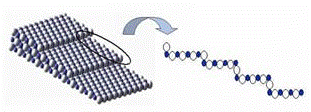Department of Chemistry
Document Type
Article
Date of this Version
February 1999
Abstract
Valence-band photoemission studies have been performed on a CoO(100) single crystal as it is slowly oxidized under 1×10-4 Torr O2 at 623 K, eventually forming a Co3O4 epitaxial film. The most significant changes occur in 3d-related features, with the peak located at the top of the valence band sharpening and shifting to lower binding energies as the spinel oxide forms. Constant initial-state measurements indicate that Co3O4 contains admixture from neighboring O 2p in its 3d band, as observed for CoO and other monoxide charge-transfer insulators. Unlike the rocksalt monoxides, which have only a single type of cobalt (Co2+) located in octahedral lattice sites, the spinel Co3O4 has both octahedral Co3+ and tetrahedral Co2+ sublattices. The peak at the top of the Co3O4 valence band results from the 3d6L final state of the octahedral Co3+ 3d band. Although some states derived from tetrahedral Co2+ may be present at the top of the valence band, the greatest contribution from the tetrahedral Co2+ sublattice appears at approximately -3.8 eV, overlapping with O 2p derived features of the spectrum. The Co3+ 3dn-1 satellite is much less intense in Co3O4 than in CoO, as is observed for the analogous structure in the cobalt 2p core spectra. An oxygen 2p-derived structure remains fairly constant throughout the oxidation process, with the exception of an intermediate species, which imparts a broad, humplike appearance centered at -5.3 eV to the O 2p region and disappears as oxidation to Co3O44 is completed. The origin of the feature is not clear; however it is most likely due either to an adsorbate or to a defectlike intermediate in the oxidation process.



Comments
Published by American Physical Society. Phys. Rev. B VOLUME 59, NUMBER 7 (1999). http://prb.aps.org. Copyright © 1999 American Physical Society. Permission to use.